
ATI Radeon 9600XT
Written by John Yan on 3/25/2004 for
PC
More On:
ATI Radeon 9600XT
While everyone of us would love to own a high end card such as a Radeon 9800XT, the reality is that we can’t all afford to shell out $400+ to get the best. The bulk of the money made come from the sales of the mid to lower end cards. With that, we look at ATI’s mid range monster, the Radeon 9600XT.
The Radeon 9600XT, or the R360, is partially a speed bump over the Radeon 9600 Pro. It runs at 100MHz faster than the Radeon 9600 Pro, clocking in at 500MHz. Memory speed is at 300MHz or 600MHz DDR at 128bits wide. Four pipelines and two vertex engines round out the general specs of the card. As with the Radeon 9800XT, the 9600XT features a thermal diode used to monitor the temperature of the card. For overclockers, you can see how hot your card is running with the help of the diode.

Physically, the card’s length is pretty average. The card is built on the .13 micron process ensuring cooler operation and less power requirements. Because of the less power needed, there is no power connector like the Radeon 9600 Pro. Instead of the green PCB used in the Radeon 9600 Pro, the familiar red one appears on the Radeon 9600XT. 128MB of ram comes in the sample that was sent to us with 256MB models available also.
The card I was sent did have an announcement of a voucher for Half-Life 2 on the cover but none was sent with the sample. The DVI-VGA converter was also missing but I’m positive you’ll find the two in ATI’s offering.
We didn’t have a comparable card from NVIDIA here to test so I’ll just show you how fast it is compared to the 9800XT at almost double the price. We’ll see if the price versus performance is really all that.
Our test system consisted of:
AMD64 3200+
ABIT KV8-MAX3
2 PC2700 256MB Crucial RAM
120 GIG Maxtor 7200RPM hard drive
Windows XP Service Pack 1
Catalyst 4.2
With each test except for Final Fantasy Online, we ran each test at three resolutions (800x600, 1024x768, 1280x1024). And I’ll also quickly explain the anti-aliasing and anisotropic filtering settings when we get to them. First up, as usual, are the synthetic benchmarks.

3D Mark 2001 SE is the first up and a synthetic benchmark from Futuremark. It’s primarily a DirectX 8.1 benchmark. Here are the scores:
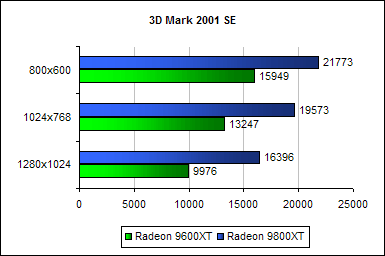
At 800x600, the card runs at 27% less than the Radeon 9800XT. As you move up in resolution, the gap increases to 40% at 1280x1024. Still, at lower resolution, the card runs pretty well compared to the very higher priced Radeon 9800X.

Our last synthetic benchmark is Aquamark 3, which is based off a real game engine. The test was conducted with default settings at 1024x768.
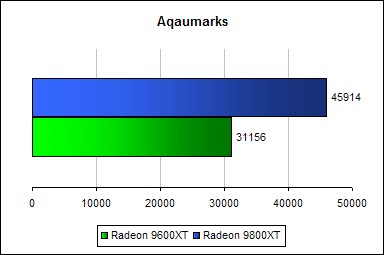
The Radeon 9600XT comes in at 37% less than the powerful Radeon 9800XT in this test. Let’s move on to real games.

Halo is the Microsoft/Bungie/Gearbox first person shooter. Tests were done at three resolutions and using pixel shader 2.0. Here are the scores.
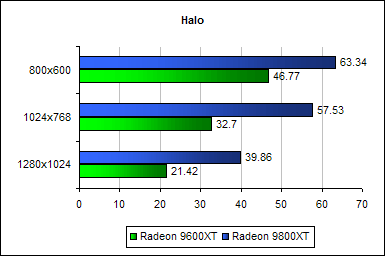
At 800x600, the card comes in at a 27% deficit again in Halo. But the card really takes it hit as you move up in resolution. At 1024x768, the card runs at a hefty 54% slower and 57% slower at 1280x1204. So far, Halo is the first game that really generates a big gap in performance between the two.

Splinter Cell is Ubi Soft’s third person stealth game that uses a modified Unreal Tournament engine. We used Beyond3D’s demo and the latest patch for Splinter Cell to run the tests.
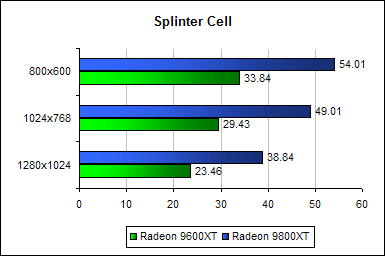
An average of around 60% in the three resolutions show the card’s deficit compared to the Radeon 9600XT. But the game’s still very playable.

Tournament 2003 was run with [H]ardOCP’s little utility. Tests were run with high quality and at three resolutions. Most tests were consistent in terms of performance difference between the two across the board so I’ll just show the scores for DM-Phobos2 flyby.
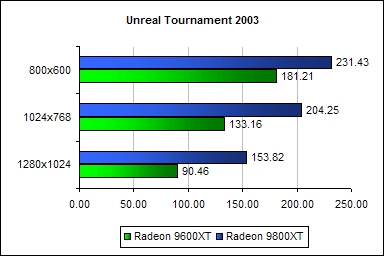
No matter what the resolution here, the Radeon 9600XT absolutely flies in Unreal Tournament 2003. With Unreal Tournament 2004 recently releaed, I’m interested to see how it holds up and we’ll be looking at that once the game is in my hands. In any case, the card is more than enough to run UT2K3.

The full version of X2: The Threat is used here at Gaming Nexus. The benchmark goes through various outer space environments with different ship architectures and sizes. Shadows were turned on and three resolutions were tested.
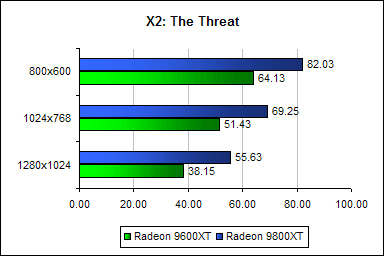
The Radeon 9600XT does an admirable job at keeping up with the Radeon 9800XT at 800x600 coming in at 22% less. As with most of the tests, the gap increases as the resolution increase and we see a 32% gap at 1280x1024.

Finally, we have Final Fantasy Online as the final game benchmark. The benchmark takes you through various environments with some dancing characters.
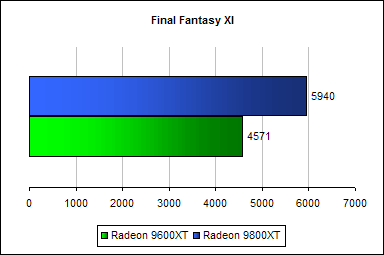
The card puts up a nice run at around a 24% deficit for this test.
For the anti-aliasing and anisotropic filtering test, I ran X2: The Threat through three settings at 1024x768. Here’s what came out of it:
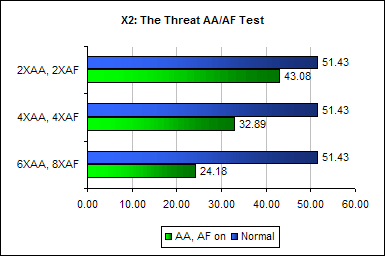
At 2xAA and 2xAF, the card doesn’t lose too much power for a slightly better image quality. You do lose a little less than half the speed at 4xAA and 4xAF and more than half when bumped up to 6xAA and 6xAF.
In the end, it all comes down to cost versus performance. Not everyone’s going to be able to afford the best and the Radeon 9600XT is a great price point for a lot of gamers. You can find a Radeon 9600XT for around $150 and a Radeon 9800XT for around $400. So the card costs 63% less than the top of the line card and comes in at 25-30% less in terms of power. That’s definitely some good bang for the buck. If you’re on a budget and want a card that performs great, the Radeon 9600XT is the way to go. And you get a coupon for Half Life 2 to boot.
The Radeon 9600XT, or the R360, is partially a speed bump over the Radeon 9600 Pro. It runs at 100MHz faster than the Radeon 9600 Pro, clocking in at 500MHz. Memory speed is at 300MHz or 600MHz DDR at 128bits wide. Four pipelines and two vertex engines round out the general specs of the card. As with the Radeon 9800XT, the 9600XT features a thermal diode used to monitor the temperature of the card. For overclockers, you can see how hot your card is running with the help of the diode.

Physically, the card’s length is pretty average. The card is built on the .13 micron process ensuring cooler operation and less power requirements. Because of the less power needed, there is no power connector like the Radeon 9600 Pro. Instead of the green PCB used in the Radeon 9600 Pro, the familiar red one appears on the Radeon 9600XT. 128MB of ram comes in the sample that was sent to us with 256MB models available also.
The card I was sent did have an announcement of a voucher for Half-Life 2 on the cover but none was sent with the sample. The DVI-VGA converter was also missing but I’m positive you’ll find the two in ATI’s offering.
We didn’t have a comparable card from NVIDIA here to test so I’ll just show you how fast it is compared to the 9800XT at almost double the price. We’ll see if the price versus performance is really all that.
Our test system consisted of:
AMD64 3200+
ABIT KV8-MAX3
2 PC2700 256MB Crucial RAM
120 GIG Maxtor 7200RPM hard drive
Windows XP Service Pack 1
Catalyst 4.2
With each test except for Final Fantasy Online, we ran each test at three resolutions (800x600, 1024x768, 1280x1024). And I’ll also quickly explain the anti-aliasing and anisotropic filtering settings when we get to them. First up, as usual, are the synthetic benchmarks.

3D Mark 2001 SE is the first up and a synthetic benchmark from Futuremark. It’s primarily a DirectX 8.1 benchmark. Here are the scores:

At 800x600, the card runs at 27% less than the Radeon 9800XT. As you move up in resolution, the gap increases to 40% at 1280x1024. Still, at lower resolution, the card runs pretty well compared to the very higher priced Radeon 9800X.

Our last synthetic benchmark is Aquamark 3, which is based off a real game engine. The test was conducted with default settings at 1024x768.

The Radeon 9600XT comes in at 37% less than the powerful Radeon 9800XT in this test. Let’s move on to real games.

Halo is the Microsoft/Bungie/Gearbox first person shooter. Tests were done at three resolutions and using pixel shader 2.0. Here are the scores.

At 800x600, the card comes in at a 27% deficit again in Halo. But the card really takes it hit as you move up in resolution. At 1024x768, the card runs at a hefty 54% slower and 57% slower at 1280x1204. So far, Halo is the first game that really generates a big gap in performance between the two.

Splinter Cell is Ubi Soft’s third person stealth game that uses a modified Unreal Tournament engine. We used Beyond3D’s demo and the latest patch for Splinter Cell to run the tests.

An average of around 60% in the three resolutions show the card’s deficit compared to the Radeon 9600XT. But the game’s still very playable.

Tournament 2003 was run with [H]ardOCP’s little utility. Tests were run with high quality and at three resolutions. Most tests were consistent in terms of performance difference between the two across the board so I’ll just show the scores for DM-Phobos2 flyby.

No matter what the resolution here, the Radeon 9600XT absolutely flies in Unreal Tournament 2003. With Unreal Tournament 2004 recently releaed, I’m interested to see how it holds up and we’ll be looking at that once the game is in my hands. In any case, the card is more than enough to run UT2K3.

The full version of X2: The Threat is used here at Gaming Nexus. The benchmark goes through various outer space environments with different ship architectures and sizes. Shadows were turned on and three resolutions were tested.

The Radeon 9600XT does an admirable job at keeping up with the Radeon 9800XT at 800x600 coming in at 22% less. As with most of the tests, the gap increases as the resolution increase and we see a 32% gap at 1280x1024.

Finally, we have Final Fantasy Online as the final game benchmark. The benchmark takes you through various environments with some dancing characters.

The card puts up a nice run at around a 24% deficit for this test.
For the anti-aliasing and anisotropic filtering test, I ran X2: The Threat through three settings at 1024x768. Here’s what came out of it:

At 2xAA and 2xAF, the card doesn’t lose too much power for a slightly better image quality. You do lose a little less than half the speed at 4xAA and 4xAF and more than half when bumped up to 6xAA and 6xAF.
In the end, it all comes down to cost versus performance. Not everyone’s going to be able to afford the best and the Radeon 9600XT is a great price point for a lot of gamers. You can find a Radeon 9600XT for around $150 and a Radeon 9800XT for around $400. So the card costs 63% less than the top of the line card and comes in at 25-30% less in terms of power. That’s definitely some good bang for the buck. If you’re on a budget and want a card that performs great, the Radeon 9600XT is the way to go. And you get a coupon for Half Life 2 to boot.
If you're on a budget and want a great card, then the Radeon 9600XT is a great option. You'll find some that have a coupon for Half-Life 2. It's speedy and doesn't need an external power supply.
Rating: 9 Class Leading
* The product in this article was sent to us by the developer/company.

About Author
I've been reviewing products since 1997 and started out at Gaming Nexus. As one of the original writers, I was tapped to do action games and hardware. Nowadays, I work with a great group of folks on here to bring to you news and reviews on all things PC and consoles.
As for what I enjoy, I love action and survival games. I'm more of a PC gamer now than I used to be, but still enjoy the occasional console fair. Lately, I've been really playing a ton of retro games after building an arcade cabinet for myself and the kids. There's some old games I love to revisit and the cabinet really does a great job at bringing back that nostalgic feeling of going to the arcade.
View Profile